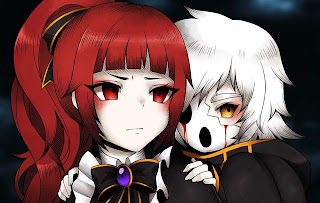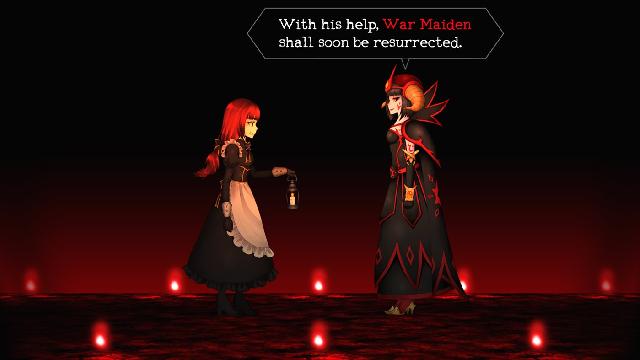It’s refreshing to see a developer turn things around like this. The original Clea was a noble idea and effort, but struggled in execution. Clea 2 takes the same basic idea that powered the original, but finds interesting ways to iterate and build on it, and feels like a much more complete package as a result.
Clea 2 is, vaguely, in the same vein as the 2D stalker horrors like The Coma or Creeping Terror. You play as a girl with no weapons who needs to sneak and out-smart her way through a series of environments while monsters are skulking around the area looking for her. If they catch her, it’s an instant game over, but thankfully it’s possible to hide in little alcoves, creep around so as to not make noise and evade detection, and peek through doors to make sure the coast is clear before marching into a new area. The developer is very proud about how there’s nothing artificial in how the monsters behave. They won’t just show up arbitarially out of thin air at random times, because that would add to the challenge (as is standard for stalker horror games), but rather, they move around the entire environment at all times, and if you play well enough to outsmart them, then you can make the game very easy for yourself.
In comparison to Clea there’s also a great deal more variety in environments to explore in Clea 2, and while they’re quite simple in design and construction, they still help to set a broader scene than we ever got in the original. The real creative energy of Clea 2 is reserved for the character models, which are big, detailed, and animated nicely. They’re also very… clean… for want of a better term, and this cuts to another key feature of Clea 2 that the developers try to make very clear; it’s horror-themed, but it’s not what we generally associate with horror in video games. There aren’t jump scares or scenes of grisly violence. This is a more elegant, gothic-like twist on the horror genre, with a greater interest in focusing players on survival, rather than trying to shock them with the grotesque.
Unfortunately, Clea 2 is still in desperate need of context to drive the atmosphere that it’s gunning for home. There is a narrative, about a cult trying to resurrect a great demon woman from the bowels of hell, but it’s handled in a very superficial, even frustrated manner. It’s hard to shake the feeling that the developer had gritted teeth as they inserted these cut scenes and narrative bits, and streamlined them as far as possible so they could get back on with the action. The problem with doing this is that for any form of horror to be effective – whether you’re looking for out-and-out terror or just a horror theme – the artist really needs to build compelling characterisation so that players can feel empathy for the character and what they’re going through. I didn’t feel too much for these characters as I was playing, and unfortunately that also meant I didn’t care too much about what was happening to them. Game Over screens were an inconvenience because it meant I needed to replay a section of the game. It was a mechanical issue, rather than an emotive one, and with the best stalker horror titles – Clock Tower 3 or Haunting Ground being my favourite two – I very much cared about the characters rather than the inconvenience when the monster caught them.
The other issue with Clea 2 is the design of some of its puzzles. The developer’s a great fan of labyrinthine levels and fetch quests – grabing an item from location X to drop it at location Y while working through mazes of corridors and rooms – and while this can be tense when you’re hearing the shuffling feet of the stalkers all around you, these tasks come across as too mundane, particularly for some of the otherworldly places that you’ll be visiting.
However, Clea 2 has a distinct ambience that does effectively elevate it as a puzzle game proxy. When you’ve got headphones on, as the game strongly recommends, trying to discern the location of enemies (and their proximity) from the sound of their footsteps is quietly intense. As is trying to then work out a path around the enemy based on their movements. Because of all the backtracking, there’s a need to memorise the locations of hiding spots, and at times deliberately make noise to draw the enemy to a certain spot. In contrast to most stalker horror, where you keep a finger close to the sprint button knowing that at some point of arbitrary timing you’re going to need to make a mad dash for freedom, Clea 2 is much more considered and cohesive. That’s a subtle thing that is quite the risk in video games – a medium that rarely reward subtlety – but it’s reflective and appealing nonetheless.
In addition to the increase in levels and locations, Clea 2 also has some excellent unlocks, including new costumes and difficulty settings, and for a game such as this, the highest difficulty setting is really the best way to play, because it feeds into the strategy of the whole experience of needng to carefully plot your way around when you won’t necessarily be able to seen an enemy before you know you need to hide from them. I almost wonder if the developer would have been better off making the higher difficulty the setting the default, before allowing players to tone it down if they found it too challenging, since the easier difficulties don’t do a great job in conveying the game’s central motifs, but of course that would raise accessibility issues.
– Matt S.
Editor-in-Chief
Find me on Twitter: @mattsainsb









